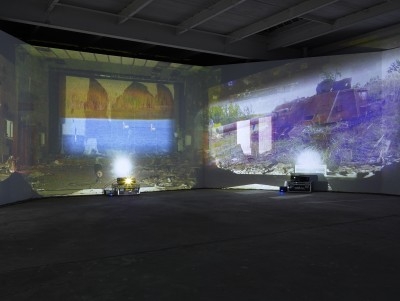‘Postapocalyptic’ deserves retirement. It’s had a long, hard-working life, and yet still doesn’t complain when it’s called up to pull the deadweight of descriptive laziness and capitulations to cliché. Take your pick of the ruined, the abandoned, the murdered land, but apocalypse will never make a genuine appearance on earth. As a concept, it’s total. Whereas our human imaginations are merely regional: we kill ourselves by the square foot, never all at once. Which is why nothing comes after the end.
Diana Thater’s Chernobyl (2010), installed in David Zwirner’s easternmost gallery space on one of the many Sandy-ravaged strips of West Chelsea, reminds us just how limited our imaginations are. Filmed in the ‘exclusion zone’, a 30-kilometre no-man’s-land that rings the 1986 meltdown site, Thater’s video reveals a remarkably vibrant sanctuary, filled with plants and animals, all undoubtedly irradiated, yet all very much alive after a generation or two or three. Centred on the wreckage of an old theatre in Pripyat, the company town whose onetime residents managed and cared for the reactor, Thater’s installation recreates the geometries of the theatre’s walls and gives us a panoramic loop that changes like Chernobyl’s diminished seasons.
The point of Thater’s piece is not to draw us once again into the depths of self-hatred whenever the subject of nuclear power and its ecological disasters are broached (though it does that too). Instead, its designs are on time itself, and the fact that it doesn’t ‘pass’ (another cliché) but is ‘lived’ and lived in. The zone around Chernobyl is occupied by much wildlife, including, amazingly, horses, specifically Przewalski’s horses, the last surviving subspecies of wild horses, which were introduced to the area because only there could they exist relatively undisturbed by humans. There are people too. Mortuary workers who care for the remains of the dead – actually, only half-dead – nuclear hulk and its burial ground.
‘Half-dead’ may not be right either. Plutonium-239 decays at a rate of 50 percent every 24,000 years. That’s a stability no human civilisation can hope to achieve (the Holocene itself only dates to about a 21 percent drawdown of the isotope). The cesium in the ground, which was meant to disappear after only 60 years, looks to be taking five times longer. These are historical scales and geological scales, both human and inhuman, and Thater’s video implicates them in their invisibility, just as a shot of the moon rising over a statue of Lenin in the video’s opening sequence implicates the ideology – equally invisible – that has irradiated us all.
This article was first published in the January & February 2013 issue.
